Sesame (sesame)

Sesame or sesame (Sesamum indicum, Sesam orientale) belongs to the Sesame family. Sesame seeds are olive fruits that are used to obtain sesame oil and as an additive to dishes. Sesame is one of the oldest oil plants in the world.
Name of sesame in other languages:
- Agyptischer Olsame - in German;
- Sesame seeds, gin-gelly - in English;
- Sesame - in French.

Appearance
Sesame is a herbaceous annual plant that can reach a height of two meters. It has erect, branched, felt-drooping stems. Green sesame leaves gradually become pointed and taper towards the tips. The lower leaflets are characterized by an ovoid shape, the length of which reaches up to 20 cm, the upper ones are lanceolate, their length is 10 cm.
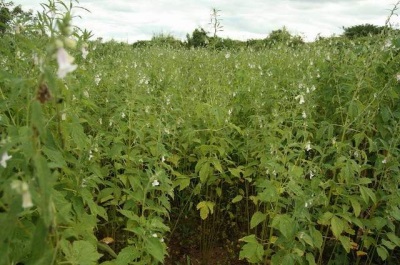
In the axils of the upper leaves, horizontally planted and slightly hanging flowers in the form of bells are formed. Their color range varies from white to purple.

The flowers form bolls with four nests. The size of such a box is 3 cm. There are many seeds inside it. Depending on the variety of sesame seeds, the color of the seeds can be white, gray, brown or black. Seeds are very popular, as they contain healthy oil and are very tasty.
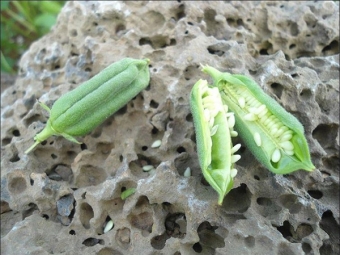
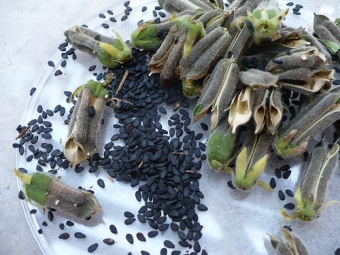
Kinds
Sesame seeds vary in color depending on the species.
There are about 35 species of this plant, but the most popular are:
- White - looks very similar to rice and belongs to rare and expensive spices.
- The black - has a rich aroma, it contains a large amount of antioxidants.
- Brown - Its seed is mild in taste and has fewer antioxidants than black seeds.
For adding to food, black sesame is the best option, in second place is brown.

Please note that the white sesame seeds sold on our shelves are culinary sesame seeds that have gone through a drying and grinding process. This purification technology removes most of the useful substances from it.
Sesame milk and halva are made from organic white sesame, these products are a valuable source of calcium and vitamin E.


Where does it grow?
Researchers suggest that the birthplace of sesame is India or East Africa. Today, this plant can be found on all continents of the world, but only in the tropical and subtropical zones. It is grown in India, China, Greece, Egypt, Central America, Ethiopia and the USA. On the territory of Russia, this plant is grown on huge plantations in the Krasnodar, Stavropol Territories and in the Crimea.

How to choose a spice?
You need to seriously approach the choice of sesame in order to get only benefits and delicious dishes from it:
- To purchase loose and dry seeds, you need to buy them in a transparent bag.
- If possible, taste the seed to make sure that there is no bitterness, which indicates a stale product.
- Regardless of the packaging of sesame seeds, you need to be sure that moisture has not got inside.
- The smell of sesame should not be sour or rotten, because this indicates a stale product.

Storage conditions
Most of the nutrients are found in raw seeds, but the only drawback is the short shelf life. Raw sesame seeds can be stored for one to three months in a cool place, checking them for bitterness before each use. If you keep them in the refrigerator, then the shelf life increases to six months, in frozen form - up to one year.
Unpeeled sesame should be stored only in sealed packaging in a dry and cool place. After cleaning, the seeds become bitter faster, so they need to be stored in the refrigerator or freezer.
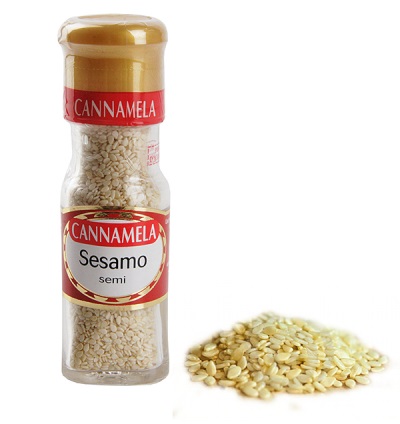
spice making method
- In early September, the sesame leaves begin to fall, so you can start harvesting.
- Whole plants are torn off, each of them contains from 50 to 100 seeds. You need to be careful, because the pod can open when harvested, and all the seeds will fall out.
- Then they are tied into small bundles and dried under the hot sun.
- Each pod is opened and the seeds are removed, which are further cleaned.
- The seeds are crushed before use.

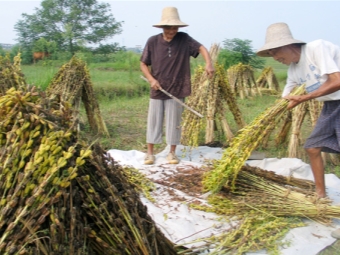
Peculiarities
- Sesame in the form of a plant has no smell.
- This spice has a mild, sweet, nutty flavor that becomes more intense after roasting.
- It blooms sesame in June and July, and bears fruit in late August or early September.
- Sesame seeds and oil are widely used.
- This spice adds spice to various dishes, because it can be applied to salty and sweet foods.

Nutritional value and calories
Sesame has a high calorie content due to the high content of fats and proteins.
100 g of sesame contains 565 kcal.
In 100 g of sesame oil - 884 kcal.
Nutritional value per 100 grams:
- Proteins - 20 grams (78 kcal)
- Fats - 49 grams (438 kcal)
- Carbohydrates - 12 grams (49 kcal)
You can find out more information about sesame seeds from the passage "Live healthy!"
Chemical composition
Sesame has a rich chemical composition, so it has a beneficial effect on the entire body. This supplement contains a large amount of useful substances.
100 grams of sesame seeds contains:
- Starch - 10.2 gr
- Mono- and disaccharides - 2 gr
- Saturated fatty acids - 6.6 g
- Ash - 5.1 gr
- Dietary fiber - 5.6 gr
- Water - 9 gr
Vitamins: Beta-carotene - 0.005 mg; E (TE) - 0.25 mg; B2 (riboflavin) - 0.247 mg; B1 (thiamine) - 0.791 mg; B5 (pantothenic) - 0.05 mg; B6 (pyridoxine) - 0.79 mg; B9 (folic) - 97 mcg; PP (niacin equivalent) - 4.515 mg; Choline - 25.6 mg.
Minerals: Iron (Fe) - 14.55 mg; Phosphorus (P) - 629 mg; Potassium (K) - 468 mg; Sodium (Na) - 11 mg; Magnesium (Mg) - 351 mg; Calcium (Ca) - 975 mg; Zinc (Zn) - 7.75 mg; Copper (Cu) - 4082 mcg; Manganese (Mn) - 2.46 mg; Selenium (Se) - 34.4 mcg.
Amount of sesame seeds in one spoon:
- in 1 teaspoon 7 grams
- in 1 tablespoon 25 grams

Beneficial features
Back in the 11th century, Avicenna paid special attention to the positive effects of sesame on the human body and described them in his treatise.
Before using sesame seeds, you need to take into account such important points:
- soaked or heated sesame has more benefits for the body than in its usual form;
- after frying and adding the plant to food, it becomes a common seasoning and loses its beneficial qualities;
- sesame seeds should not be heavily thermally processed so that it retains its characteristics;
- Sesame must be thoroughly chewed, then the healing effect will increase significantly. If you pre-soak it, then it will be much easier to chew.
Eating raw sesame seeds will help to cope with various problems:
- Sesame helps to normalize lipid-fat metabolism, lower cholesterol levels.
- The plant enhances immunity due to unique components.
- Sesame helps to remove all harmful substances from the body.
- Sesame seeds have a large amount of fiber, so they have a beneficial effect on the condition of the intestines.
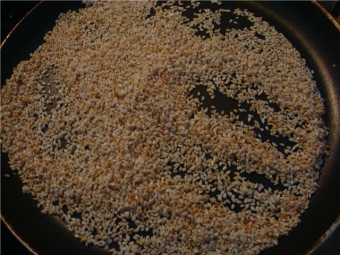

Harm
Sesame should be used with extreme caution during pregnancy, because it negatively affects the development of the unborn baby and can provoke a miscarriage if used excessively.
With increased acidity of the stomach, sesame will irritate the mucous membrane even more. It is strictly forbidden to take it on an empty stomach, because it can cause nausea and vomiting. To prevent such symptoms, it is necessary to roast the seeds, and then add honey.
Contraindications
- with urolithiasis;
- with increased blood clotting;
- with thrombosis and thrombophlebitis;
- with diseases of the gastrointestinal tract;
- with kidney disease;
- with individual intolerance.
Application
In cooking
Sesame goes well with any dish, so you can connect your imagination and make food even more aromatic and tastier. To make the aroma of sesame seeds stronger, you just need to toast its seeds a little in a pan. Ground seeds are used in porridge or sushi, and they are also sprinkled on salads. Sesame confectionery is especially popular.



Salad with sesame
Ingredients:
- 200 grams of spinach
- 30 grams of sesame
- 4 tbsp. spoons of olive oil
- ½ lemon
- A pinch of curry spice or saffron
- Salt, pepper and fresh herbs to taste
- Sesame seeds for decoration
Cooking
Wash and dry the spinach, use its leaves.To prepare the sauce, you need to take oil, lemon juice, curry or saffron, as well as a pinch of salt and pepper. Mix everything well. Put the spinach leaves on a plate, sprinkle with sesame seeds on top, pour the sauce and decorate with fresh herbs.

sesame cookies
Ingredients:
- 300 grams of flour
- 60 grams of butter
- 200 grams of cheese (preferably Swiss or cheddar)
- 2 tbsp. spoons of sour cream
- 1 egg
- 50 grams of sesame seeds (preferably white)
- Salt to taste
- Sesame seeds as decoration
Cooking
Grate the cheese on a small grater. Mix cheese, flour and chilled butter in the form of small cubes into a single mass. You can use a blender. You need to add sour cream, egg and sesame seeds and continue to mix until a ball forms. The dough in the film is placed in the refrigerator for half an hour. Take a board and sprinkle with flour. Roll out the dough so that its thickness is about 5 mm. Using your cookie cutter, make round cookies. The recommended mold diameter is 3 cm. Put the cookies on a baking sheet previously greased with vegetable oil. The distance between the cookies should be about 2 cm. Beat the egg and brush a little on top of each cookie, and then sprinkle with sesame seeds. Bake in the oven at 180 degrees for 15 minutes.

Chicken in sesame
Ingredients:
- 300 grams of chicken fillet
- 50 grams of cucumbers
- 1 egg
- 100 grams of sesame seeds
- ¼ teaspoon monosodium glutamate
- 2 teaspoons curry spoons
- 1 st. a spoonful of corn starch
- 4 tbsp. tablespoons of vegetable oil
- Salt and herbs to taste
Cooking
Thoroughly wash the chicken fillet and cut into thin pieces. Dilute starch with water and add egg, monosodium glutamate, curry and salt. Pour the mixture over the chicken and let it brew for 30 minutes.Place the sesame seeds on a plate and roll the chicken in them. Fry the chicken fillet in a pan with sunflower oil until golden brown. Put the chicken meat on a plate and garnish with fresh cucumbers and herbs.

You can cook oriental (tahini) sesame halva. Watch the next video.
In medicine
Sesame should be consumed in small quantities in order to derive only benefits for the body. The daily norm is two to three teaspoons.
The composition of sesame includes many useful substances that have a beneficial effect on the entire human body:
- Sesamin is a powerful antioxidant, so it helps to cope with various diseases, and also has a positive effect on cancer.
- Sitosterol affects the level of cholesterol in the blood and lowers it.
- Fitin helps to regulate the mineral balance of the body.
- Riboflavin is responsible for human growth, and also has a positive effect on blood composition.
- Thiamine is responsible for metabolism in the body and has a positive effect on the functioning of the nervous system.
- Calcium prevents the occurrence of osteoporosis, because it is the main component of bones and joints.
- Phytosterol helps with atherosclerosis and obesity, because it reduces the level of cholesterol in the blood.
- Phytoestrogen has a positive effect on the female body after 45 years, it can replace female sex hormones.
Raw sesame seeds should be used for such diseases:
- Low blood pressure
- Pneumonia
- liver problems
- Diseases of the pancreas or thyroid gland
- Joint disease
- Colds, flu and asthma

Sesame is a fairly important source of lime in the body, so it is recommended to use it regularly.Just 10 grams of sesame per day is enough to get the required amount of lime, which is very scarce in vegetable and fruit juices, as well as in other products. Sesame also allows you to muffle the feeling of hunger, you just need to chew a few seeds.

Some recipes for the treatment of various diseases with sesame seeds:
- For indigestion You need to take 200 ml of chilled boiled water and add 1 tbsp. a boat of liquid honey. Next, grind the seeds and add 1 teaspoon to the prepared mixture. This solution must be consumed several times a day in small portions.
- With mastitis in women during lactation, a compress will help solve this problem. First, you need to fry the seeds on low heat, and then grind them to a powder, mix with vegetable oil, then this mixture should be wrapped in gauze and applied to the chest.
- For rejuvenation, a remedy from 1 tbsp. tablespoons of sesame seeds, 1 teaspoon of ginger (ground), 1 teaspoon of powdered sugar. You need to use this mixture once a day for 1 teaspoon.
- Plant seeds are used to cleanse and heal the body. It is necessary to consume about 15-20 grams of sesame powder in the form of a powder before meals and drink it with water three times a day.
- For hemorrhoids, you need to take 2 tbsp. tablespoons of sesame powder, then pour it with 500 ml of boiling water and cook over low heat for about 5 minutes. Then you need to cover the contents and insist until completely cooled. A decoction is used for external application to inflamed areas.
- For pain in the lumbar region or arms and legs due to inflammation of the tissue of nerve fibers, a sesame-based remedy will help. First, the seeds are fried in a pan, then finely chopped. Take one tablespoon of sesame seeds and honey once a day.For the best effect, you can drink the mixture with warm water with ginger juice.



Varieties
Sesame, which is grown in India, can be of two varieties:
- purified
- ordinary
The State Register of Russia in 2006 included only three varieties of sesame:
- Kubanets 55;
- Solar;
- Kuban 93.
cultivation
Sesame seeds are essential for growing sesame seeds. They are sown in the ground if it has already warmed up to about 20 degrees, because this plant loves heat. The air temperature should be between 25 and 30 degrees.
Before planting seeds, you first need to loosen the soil several times to eliminate weeds, because they will muffle the growth of plants that grow rather slowly for the first month.
Then apply fertilizers per square meter 30 grams of ammonium nitrate, 100 grams of superphosphate, 20 grams of potassium chloride. You can expect a good harvest if you use 10 grams of granulated superphosphate per 1 square meter.
Sowing is carried out in rows, between which it is necessary to maintain a distance of 45 to 60 cm. Approximately 0.6 grams per hundred square meters of soil is used. The seed planting depth is 3-4 cm.
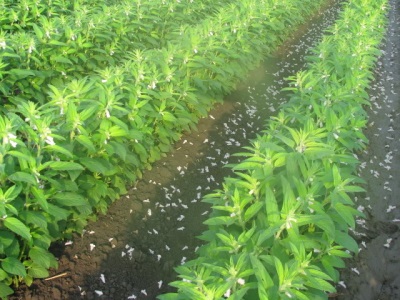
When growing sesame, special attention should be paid to the level of moisture in the soil, because from the moment of sowing until the middle of flowering, moisture should be sufficient. After flowering, sesame copes with soil drought, but does not tolerate atmospheric.

Interesting Facts
- Sesame is credited with magical properties, it is believed that it is included in the recipe for the elixir of immortality.
- Many people know that Ali Baba's magical cave came off with the password: "Sim-sim open!". Sim-sim in Arabic is translated as sesame.


















I sprinkle sesame seeds on top of the casserole) My daughter loves it very much. Looks interesting and useful too!